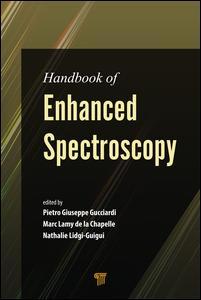Handbook of Enhanced Spectroscopy
Coordonnateurs : de la Chapelle Marc Lamy, Gucciardi Pietro Giuseppe, Lidgi-Guigui Nathalie

Techniques such as Raman, infrared, fluorescence, and even nonlinear spectroscopies have recently grown in resolution and possibilities thanks to the use of nanostructured surfaces. Excitation of localized surface plasmon (LSP) and/or the use of specific shapes of nanostructures have made it possible to gain an incredible sensitivity in these spectroscopies. Unlike other books in the market, which mainly focus on surface-enhanced Raman spectroscopy (SERS) and plasmonics, the aim of this book is to provide the reader with a detailed overview of enhanced spectroscopies. It introduces plasmon and electromagnetic effects arising in metallic nanostructures, and reviews the above spectroscopies, enhanced by the presence of either a nanostructure or a tip. It reviews the theoretical basis of each technique, describes experimental procedures, and suggests some applications.
Preface. Enhanced spectroscopy. SPR-LSPR and applications. Modeling of enhanced electromagnetic fields in plasmonic nanostructures. Synthesis of metallic nanostructures. SERS: Fundamentals and biosensing applications. Polarized SERS. Synthesis of SERS-active substrates by pulsed laser ablation. Surface-enhanced multipurpose nanosensing with microneedle-shaped fiber optics.Isotope dilution SERS: Metrologically traceable reference measurements at the highest precision level and their application in clinical chemistry. SERS applications—Sensors—Pollutants and chemical detection. TERS: Principle and instrumentation. TERS: Application to carbon nanomaterials. 20 nm-resolved stress profile in SiGe nanostripes obtained by TERS. Surface-enhanced infrared spectroscopy. Enhanced spectroscopies based on nonmetallic nanoparticles.
Pietro Giuseppe Gucciardi is a researcher of the Institute for Chemical and Physical Processes (IPCF) of the Italian National Research Council, where he coordinates the Spectroscopy, Imaging and Trapping Group activities. His research interests are in nano-optics and plasmonics, aimed at developing advanced molecular sensors based on surface- and tip-enhanced spectroscopies, also in combination with optical trapping techniques.
Marc Lamy de la Chapelle is a professor at the Laboratory of Chemistry, Properties and Structure of Biomaterials and Therapeutics Agents (UMR 7244) of the Université Paris 13, Sorbonne Paris cité, France. He is also head of the "spectroscopies of biomolecules and biological media" research team and director of the CNRS national research network on molecular plasmonics and enhanced spectroscopies. His research activities are focused on nano-optics and Raman spectroscopy. His research subject is the application of SERS and TERS to biological issues and more especially to the disease diagnosis.
Nathalie Lidgi-Guigui is an associate professor at the Laboratory of Chemistry, Properties and Structure of Biomaterials and Therapeutics Agents (UMR 7244) of the Université Paris 13, Sorbonne Paris cité. In 2011 she joined Prof. de la Chapelle’s group, where her research work mainly deals with surface structuration using innovative lithography techniques, molecular plasmonics, and application of SERS to sensing.
Date de parution : 10-2015
13.8x21.6 cm
Disponible chez l'éditeur (délai d'approvisionnement : 15 jours).
Prix indicatif 172,36 €
Ajouter au panierThèmes de Handbook of Enhanced Spectroscopy :
Mots-clés :
SERS Active Substrate; raman; SERS Spectrum; scattering; SERS Signal; spectra; SERS Substrate; polarizability; SERS Activity; tensors; SERS Measurement; surface; Raman Scattering; plasmon; American Chemical Society; enhancement; SERS; factors; Raman Polarizability Tensor; apex; Surface Plasmon Resonance; Surface Enhanced Raman Scattering; Dielectric Function; Tip Apex; SERS Detection; LSPR Shift; SERS Enhancement; Depolarization Ratio; SPR Sensor; Pulsed Laser Ablation; LSPR Sensor; Polarizability Tensor; Laser Pulse Number; UV Vis Absorption Spectrum; Sea Water



